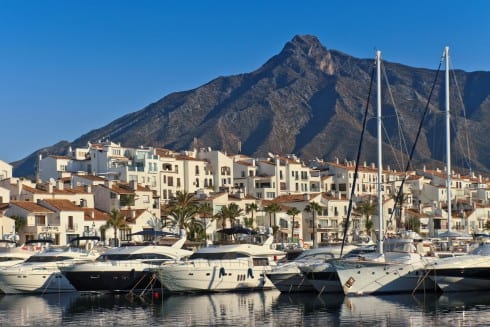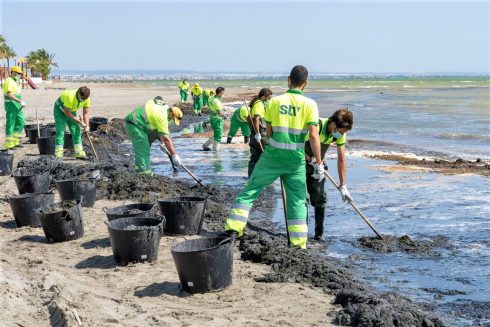IT is, without a doubt, one of the best examples of Romanic ‘des res’.
Sited high up on an escarpment with views for miles around, the 1000-metre squared Roman villa must have been sumptuous in the extreme.
Aside from its indoor fountains, statues and plunge pools, it had wall to wall mosaics on the floor and beautiful frescoes on the walls.
Its main bedroom was designed to maximise the views, while the dining room – or triclinium – had a waterfall and channels running through it and a raised podium where guests would recline to eat.
There was even underfloor heating, not to mention large staff quarters, where perhaps up to a dozen slaves would have been housed.
Yes, the Roman leader, or merchant, who lived in the recently discovered villa in Almedinilla certainly had it good.
Yet, were it not for the construction of the new A340 around the small village it would never have been found.
In fact, the road was originally scheduled to go right over it.
But fortunately plans were altered at the last minute and over the last two decades archaeologists have managed to uncover what is thought to be the most intact Roman villa in Spain.
Inhabited between the first and fifth centuries, it shows the sheer luxury that the leading merchants of the time were accustomed to.
It also serves as the perfect testament to the wealth of the Subbetica area, which has been producing some of the world’s best olive oil for nearly 2,000 years.
Indeed, it is no coincidence that today three of Spain’s top areas for olive oil production are in the Subbetica.
The DO’s – or denominacion de origines – of Lucena, and particularly Priego and Baena (under which the village of Almedinilla falls) are famous worldwide for their mixture of rich and complex olive oils.
It is certainly the best product of the Subbetica region (although the wines of Montilla-Moriles aren’t far behind), which comprises 14 towns, sited in the south of Cordoba province.
It is no coincidence that today three of Spain’s top areas for olive oil production are in the Subbetica.
Described as the ‘geographic centre of Andalucia’ for its close proximity to the Costa del Sol, Cordoba and Granada, the Subbetica is full of historic towns, interesting archaeological sites, and wonderful walks.
But, best of all, is the scenery, in particular, in the Subbetica Natural park, near Priego, and around the stunning Iznajar reservoir, which is full for the first time in decades.
Fringed by pine plantations and oceans and oceans of olives, distant sierras provide the stunning backdrop, while resident birds such as hoopoes and bee eaters swoop across its surface for sustenance.
There is hardly a house, let alone block of flats or golf course, to ruin the view, and taking a walk uphill on numerous dirt tracks is bound to lead you to pretty ruined farmsteads and herds of goats.
Iznajar itself is one of the true picture postcard towns of southern Spain – easily rivalling Ronda and Olvera for its scenery.
Perched on a rocky outcrop that erupts out of the lake, it is peace personified, overlooking the reservoir, which is some 30kms in length and crosses the three provinces of Cordoba, Malaga and Granada.
Known as the ‘Mirador of the River Genil valley’, it is hardly surprising then that Iznajar is fast becoming one of the most desirable inland destinations in Andalucia.
A fashionable place to buy, over the last few years various Spanish politicians and sporting starts have bought in the area, not to mention English businessmen and lawyers.
Other interesting residents include the former captain of Wasps rugby team, who once played for the All Blacks, as well as Peter Reynolds, a former British Defence Attache in Argentina and Venezuela.
“We are mountain people but we like the sea as well, so looking over the lake is a major bonus,” explains Reynolds, a former Royal Marine, who has lived with his wife yoga teacher Marilyn near Iznajar for six years.
Next I spoke to two judges, no less, having a candlelit dinner in the pebbled courtyard of the atmospheric hotel Cortijo La Haza near the town.
Recently having bought in the area, they have become firm fans of the lake-side town, which serves as their escape from the rat race back home in England. “We love the countryside and peace,” explained one, asking to remain anonymous.
But it certainly does not take long to fall under the spell of the town. Originally a prehistoric settlement, its fortunes changed in the seventh ventury when Arab settlers built a castle on the promontory and named it Hins Ashar.
Iznajar Castle is one of the oldest Moorish fortresses in the region and the ruins are now undergoing full restoration.
It is a wonderful place to visit, particularly in the evening, as the hot Andalucian sun starts to drop, its last rays giving an ethereal light to the historic houses around the old castle.
The locals come and go, many dropping into the impressive Church of Santiago, which was built in the 17th Century and has a beautiful baroque chapel behind the altar.
On leaving the church you stroll past a small square called the Patio de las Comedias which lends credence to the fact that Iznajar once had a theatre culture – even in Arabic days.
It is a pretty site, beautifully kept by its proud neighbours, who bedeck its walls with blue flower pots full of geraniums.
It is a similar story in the pretty Barrio de la Villa in the heart of Priego de Cordoba, a lovely 30-minute drive north of Iznajar through rolling olive groves and past romantic ruined farmhouses.
Here in the maze of cobbled old streets, dating back to Moorish times, you will find the house of Adoracion Montecille, 74, who moved here from Madrid eight years ago.
Her chain of 200 plant pots spreads organically some 50 metres up the side wall of the narrow bumpy street where she lives.
With dozens of different types of geraniums, in a profusion of colours, it has become something of an obsession to the pensioner, who religiously waters and prunes them every evening through the heat of the summer.
But that is not all. Since moving back to Priego – known as ‘the city of water’ – and where she was born in the 1930s, Adoracion has also become as communally minded as the rest of the Barrio.
Spic and span, not thanks to the local council, but thanks to the army of old age sweepers, who take out their brooms and sweep their area at sunset in a communal dedication rarely seen these days.
This is typical of the Cordoban love of patios and the narrow streets of the charming car-free barrio they inhabit.
It is all too obvious strolling around the lovely district, which is a warren full of white-washed houses and interesting nooks and crannies, such as the charming Plazuela de San Antonio, with its palm trees and pretty houses, replete with wrought-iron rejas.
Little changed since Moorish times, it is not dissimilar to the old parts of Cordoba capital, and is fringed by an ancient Balcon de Adarve walkway, which has a lovely view over the local countryside, not to mention a good restaurant of the same name.
Eventually you will wind up at the big prize, the stunning Iglesia de la Asunción, on Plaza de Abad Palomino which is rightly thought to be one of Spain’s most important Baroque churches.
The church has an unmissable gilded and multi-layered, blue-pitched roof.
Inside though, it is all the more impressive, with an ornate white stucco Baroque interior leading towards a stunningly beautiful carved retalbo.
The greatest surprise of all, though, lies through a portal to the left, where you enter the breathtaking sagrario, one of the masterpieces of 18th century Spanish architecture.
Quite rightly granted ‘National Monument’ status, this heavenly side chapel takes the eye up to the skies to a feast of religious imagery, hard to comprehend in such a small town.
Sitting conveniently right next to the church’s south door is hotel/restaurant Zahori, well worth a visit whatever time of day.
It is here that English student Adam White, 23, ended up working for his summer holidays thanks to a blossoming romance with the owners’ daughter Gema, who studied with him at Exeter University.
“It is the most wonderful town,” says Adam, who has been coming to Priego for the last six years. “The people are incredibly friendly and the way of life is very slow and relaxed. Here everyone thinks about the family, and everyone mucks in to help.”
Capital of the Subbetica region, Priego is a great place to spend a weekend. Sitting in the heart of a rolling area of hills – much of it, some 32,000 hectares, now designated as the Parque Natural Sierras Subettica – it has a contented self-contained air about it.
Much to do with its decent selection of shops and markets, it is still extremely Spanish in feel; few British have yet tomove to the area and tourists are not as common as they ought to be.
In terms of history, this month is a great time to visit Priego due to the so-called Domingos de Mayo, which since 1999, have been declared of national interest for tourism.
The ancient processions, which take place each Sunday, are stunning and first began in 1642.
Priego itself first became known in Roman times as the cattle town of Rueda, which came under the jurisdiction of nearby Carcabuey.
While nowadays few cows wander the area, it has become extremely well known for its goats, and in particular, olive oil.
The town competes fiercely with the other notable olive oil town of Baena, which sits on the other side of the national park, and counts award-winning Nunez del Prado, which is said to be one of Spain’s best.
One olive oil producer Benito Serrano, from Priego, explains: “The olive oil here is the best in Spain. It is clean and fruity and great with bread and salads.”
Taking the charming CP-072, you will wind up into the Subbetica natural park, heading past the highest peak of La Tinosa, which sits at 1570 metres, until after around half an hour you reach Zuheros.
A stunning town, sitting high on a promontory and backed by a backdrop of cliffs and a gorge, Zuheros is one of the true gems of Andalucia.
Little-known and little visited, the attractive village has a sleepy relaxed feel akin to somewhere in Extremadura or Teruel.
A cluster of whitewashed houses tumble down to an old Moorish castle built on and into a steep rock face.
Later it was used as one of the bases of Fernando III, after the town was seized from the Moorish Kingdom of Granada in 1240.
The town, which still has a distinct frontier feel to it, is perhaps best known for its cheeses and there are around 10,000 goats living in the park.
But there is one local product of the Subbetica that is perhaps even more highly sought after: the furniture of Lucena.
On first glance an ugly town, Lucena is extremely underated as a place to visit. Its success story is also the reason for its ugliness, for the town is now ringed with hundreds of furniture factories and emporiums.
The growth of the furniture industry has turned it into Cordoba’s second biggest town, not to mention one of Andalucia’s most prosperous.
It is a remarkable turnaround for this now booming place, which was once described by the writer, Gerald Brenan, as one of the poorest Spanish towns he had come across.
Many of its olive groves and vineyards have been pulled down to make way for new factories, not to mention suburbs, and it counts the largest discoteque in Andalucia, so claim its locals, not to mention the world’s largest chair, which at 26 metres tall sits outside the Hermanos Huertas factory on the ring road.
Once you get inside the town, formerly known as Eliossana or Perla de Sefarad in Arabic times, it is actually a wonderful place to spend a morning.
It has plenty to offer in terms of sites, and is a nice place for a wander, with its shady squares full of children playing. In particular make sure to visit the baroque church of San Mateo, with its Sagrario chapel, which has exquisite plasterwork and a magnificent encrusted marble entrance.
During the middle ages, the Jewish community in Lucena was one of the most prosperous in Spain and parts of it are still around to visit.
Other monuments include the 17th century church of San Agustin with a unique oval layout and domed tower, and the Church and Hospital of San Juan de Dios, with a marble entrance and baroque altarpiece. You might also take a peek inside the headquarters of the local TV station, one of the oldest in Andalucia, which is installed inside a former merchant’s house with stunning 100-year-old frescoes.
Most interesting is the restored Castillo del Moral, where the last Arabic leader of Spain Boabdil, was held in 1483 after being captured by Isabella.
Another pleasant surprise, a short ten minute drive east is Cabra, which must go down as one of the friendliest towns in Andalucia.
Much bigger than one might expect, the town of 22,000 people, has an important and illustrious history going back many centuries.
It is a great place for a wander – in large part due to its clever pedestrianisation – and it has two distinct areas worth spending time in, one up by the castle (which is now a school) and the other in the heart of the old town.
Here, you will find pleasant, winding streets, full of baroque buildings, with rejas bedecked in geraniums.
In particular, look for the Iglesia de la Asuncion, which is built over a mosque, and the church of San Juan Bautista, which is Visigothic in origin and said to be one of the oldest churches in Spain.
Cabra was also the home of Arabic poet Al Cabri who became renowned for his ‘erotic’ love songs in the 11th century. Known as ‘the blind man of Cabra’, there is a statue of him up by the castle.
While in town also make sure to visit the riding stables La Garrocha on the outskirts, where you can hire horses for the day, and head for lunch in Trama y Azahara, a restaurant installed in a recently converted olive mill.








